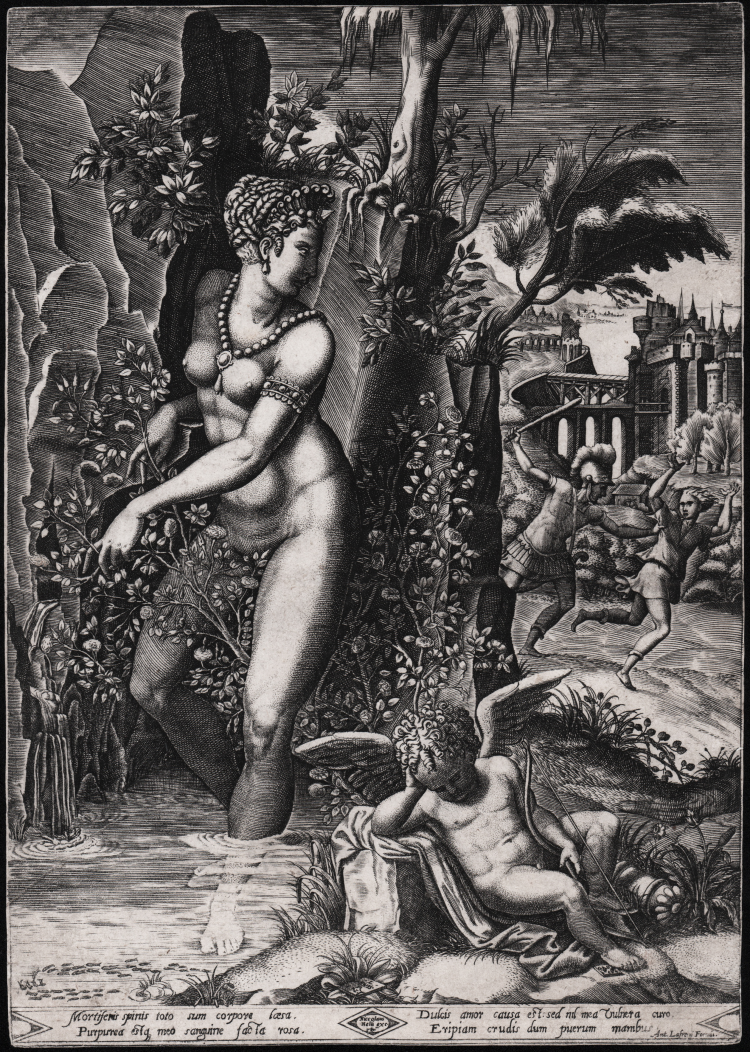




| Reference: | S32752 |
| Author | Gaspare OSELLI detto "Gaspare degli Uccelli" |
| Year: | 1564 |
| Measures: | 208 x 294 mm |



| Reference: | S32752 |
| Author | Gaspare OSELLI detto "Gaspare degli Uccelli" |
| Year: | 1564 |
| Measures: | 208 x 294 mm |
Engraving, 1564, inscrideb on a tablet lower right “Gas/ .P. F. /1564”.
Inscribed on a tablet lower centre: '.L./PENIS/.R./.IN.', and in the lower margin with a Latin poem of two distychs: 'Mortiferis spinis toto sum corpore loesa./Purpurea estq. meo sanguine facta rosa./Dulcis amor causa est: sed nil mea vulnera curo./Eripiam crudis dum puerum manibus'.
Example in the second state, of three, with “Ant. Lafrerij Formis” added in the bottom right corner to the inscription “Niccolaus /Nelli exc” in a diamond in center of bottom margin.
Magnificent example, rich tones and good contrast, printed on laid paper with an unidentified watermark, complete of the marginal line, a paper fold in the left margin, overall in excellent condition.
This magnificent work is a copy, in the same direction and about the same size, after Giorgio Ghisi’engraving, dated 1556.
It is one of six engravings, so far known, that in 1564 Gaspar ab Avibus made after his teacher Giorgio Ghisi.
The composition for this print is based on a design (now lost) by Luca Penni, who in turn was influenced by an episode in the Hypnerotomachia Polifili, as can be seen in the poses of the three main figures. In this episode, Venus scratches her leg upon a rosebush, while Mars attacks Adonis. It is the blood of Venus which transforms the white rose to red.
The Latin inscription at the bottom of this Ghisi print gives us a clue as to what is happening:
"With deadly thorns I have been wounded in my whole body, and the rose has become purple through my blood/
Sweet love is the cause, but in no way do I care for my wounds [i.e., I won't attend to my wounds at all] Until I rescue the boy from cruel hands”
A very rare work
|
G. Streliotto, Gaspar ab Avibus, p. 24 n. 4; Bartsch XV, 400 n. 40; Lewis, p. 95 n. 22; Bellini, pp. 129-135
|
Gaspare OSELLI detto "Gaspare degli Uccelli"
|
Although Gandellini wants him to be flourishing in 1577 and Basan qualifies him as Cesare de Avìbus and more often Cesar patavinus making him born in 1645 it constitutes on the other hand from incontrovertible evidence and from repeated legends affixed in various of his works that only around the year 1536 was he born in Cittadella and not Padua and that initiated at the school of Mantuan Giorgio Glusi in a short time he rivalled him in the handling of engraving His main prints in fact bear the date from 1560 to 1580 and are signed in different manners: Gaspar patavinus; Gaspar ab Avibus Citadelensis; Gasparo Oselle padovano; etc. In the style of the Sadelers he then carved in 72 pieces the portraits of the princes of the house of Austria for V by Francesco Terzi l of Bergamo, where in addition to a particular display of architecture there is a bizarre and magnificent grafting of sumptuous draperies of armor and emblems (N. Pietrucci, Biografia degli artisti Padovani).
|
|
G. Streliotto, Gaspar ab Avibus, p. 24 n. 4; Bartsch XV, 400 n. 40; Lewis, p. 95 n. 22; Bellini, pp. 129-135
|
Gaspare OSELLI detto "Gaspare degli Uccelli"
|
Although Gandellini wants him to be flourishing in 1577 and Basan qualifies him as Cesare de Avìbus and more often Cesar patavinus making him born in 1645 it constitutes on the other hand from incontrovertible evidence and from repeated legends affixed in various of his works that only around the year 1536 was he born in Cittadella and not Padua and that initiated at the school of Mantuan Giorgio Glusi in a short time he rivalled him in the handling of engraving His main prints in fact bear the date from 1560 to 1580 and are signed in different manners: Gaspar patavinus; Gaspar ab Avibus Citadelensis; Gasparo Oselle padovano; etc. In the style of the Sadelers he then carved in 72 pieces the portraits of the princes of the house of Austria for V by Francesco Terzi l of Bergamo, where in addition to a particular display of architecture there is a bizarre and magnificent grafting of sumptuous draperies of armor and emblems (N. Pietrucci, Biografia degli artisti Padovani).
|